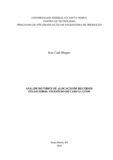| dc.creator | Huppes, Jean Cauê | |
| dc.date.accessioned | 2017-01-20 | |
| dc.date.available | 2017-01-20 | |
| dc.date.issued | 2016-08-26 | |
| dc.identifier.citation | HUPPES, Jean Cauê. Index of allocation of financial resources of public colleges: a case study at UFSM. 2016. 70 f. Dissertação (Mestrado em Engenharia de Produção) - Universidade Federal de Santa Maria, Santa Maria, 2016. | por |
| dc.identifier.uri | http://repositorio.ufsm.br/handle/1/8414 | |
| dc.description.abstract | This research sought to identify the variables of greater impact in shaping the Student
Equivalent Index Nfte (G), which is used for the allocation of resources in the eight learning
centers of the Federal University of Santa Maria, RS, in order to describe through a set of
variables related to the budget through the main instruments of planning and control of
resources made available to the Brazilian public universities. The data have been obtained
from the data processing center of the Federal University of Santa Maria, in the period from
2010 to 2013. The results show that the variables that contribute most to the formation of the
(Nfte (G)), are number of Graduates (Ndi) and number of Freshmen (Ni). The largest courses
(Nfte (G)) are: Medicine, dentistry, veterinary medicine, Civil Engineering, electrical
engineering and mechanical engineering. The courses less contribute in the formation of (Nfte
(G)) are: Music and Spanish Course. The courses in a second moment, was applied to cluster
analysis, which identified with a high degree of similarity between the Ndi and Ni throughout
the analysis period. It should be noted, too, that these variables are the only ones that can be
directly modified by means of the interaction of public policies. During all years analyzed, the
variable retention R was the most inconclusive, corresponding to the lowest average. Also it
was found that the clusters presented the same structure of agglomeration.
In order to verify the more similar courses, cluster analysis, considering them as variables.
Over the years, the more disparate courses were the same presented in descriptive analysis.
They are: Medicine, animal science, dentistry, Civil Engineering and mechanical engineering.
The more similar courses were bachelor courses. It was noted that, in the four years
examined, the subdivision of the groups was also. | eng |
| dc.format | application/pdf | por |
| dc.language | por | por |
| dc.publisher | Universidade Federal de Santa Maria | por |
| dc.rights | Acesso Aberto | por |
| dc.subject | Índice aluno equivalente | por |
| dc.subject | Análise de cluster | por |
| dc.subject | Análise fatorial | por |
| dc.subject | Resource allocation index | eng |
| dc.subject | Cluster analysis | eng |
| dc.subject | Factor analysis | eng |
| dc.title | Análise do índice de alocação de recursos financeiros: um estudo de caso na UFSM | por |
| dc.title.alternative | Index of allocation of financial resources of public colleges: a case study at UFSM | eng |
| dc.type | Dissertação | por |
| dc.description.resumo | Esta pesquisa buscou identificar as variáveis de maior impacto na formação do Índice
Aluno Equivalente Nfte(G), O qual é utilizado para a alocação de recursos nos oito Centros de
Ensino da Universidade Federal de Santa Maria, RS, afim de descrever através de um
conjunto de variáveis relacionadas ao orçamento através dos principais instrumentos de
planejamento e de controle dos recursos colocados à disposição das universidades públicas
brasileiras. Os dados foram obtidos junto ao Centro de Processamento de Dados da
Universidade Federal de Santa Maria, no período de 2010 a 2013. Os resultados mostram que
as variáveis que mais contribuem na formação do (Nfte(G)), são Número de Diplomados (Ndi)
e Número de Ingressantes (Ni). Os cursos de maior (Nfte(G)) são: Medicina, Odontologia,
Zootecnia, Engenharia Civil, Engenharia Elétrica e Engenharia Mecânica. Os cursos que
menos contribuem na formação do (Nfte(G)) são: Música Licenciatura e Letras Espanhol. Os
cursos Num segundo momento, foi aplicada a análise de cluster, que se identificou com um
alto grau de similaridade entre as variáveis Ndi e Ni ao longo do período analisado. Salientase,
também, que essas variáveis são as únicas que podem ser diretamente alteradas por meio
da interação de políticas públicas. Durante todos os anos analisados, a variável retenção R foi
a mais discrepante, correspondendo à menor média. Também se verificou que os clusters
apresentaram a mesma estrutura de aglomeração.
Com o intuito de verificar os cursos mais similares, foi realizada a análise de cluster,
considerando-os como variáveis. Ao longo dos anos, os cursos mais discrepantes foram os
mesmos apresentados na análise descritiva. São eles: Medicina, Zootecnia, Odontologia,
Engenharia Civil e Engenharia Mecânica. Os cursos mais similares foram os cursos de
licenciaturas. Constatou-se, ainda, que, nos quatro anos analisados, a subdivisão dos grupos se
caracterizou igualmente. | por |
| dc.contributor.advisor1 | Souza, Adriano Mendonça | |
| dc.contributor.advisor1Lattes | http://lattes.cnpq.br/5271075797851198 | por |
| dc.contributor.referee1 | Cassanego Junior, Paulo Vanderlei | |
| dc.contributor.referee1Lattes | http://lattes.cnpq.br/7581727785609073 | por |
| dc.contributor.referee2 | Ansuj, Angela Pellegrin | |
| dc.contributor.referee2Lattes | http://lattes.cnpq.br/4331195282444316 | por |
| dc.creator.Lattes | http://lattes.cnpq.br/2831572911584680 | por |
| dc.publisher.country | BR | por |
| dc.publisher.department | Engenharia de Produção | por |
| dc.publisher.initials | UFSM | por |
| dc.publisher.program | Programa de Pós-Graduação em Engenharia de Produção | por |
| dc.subject.cnpq | CNPQ::ENGENHARIAS::ENGENHARIA DE PRODUCAO | por |


